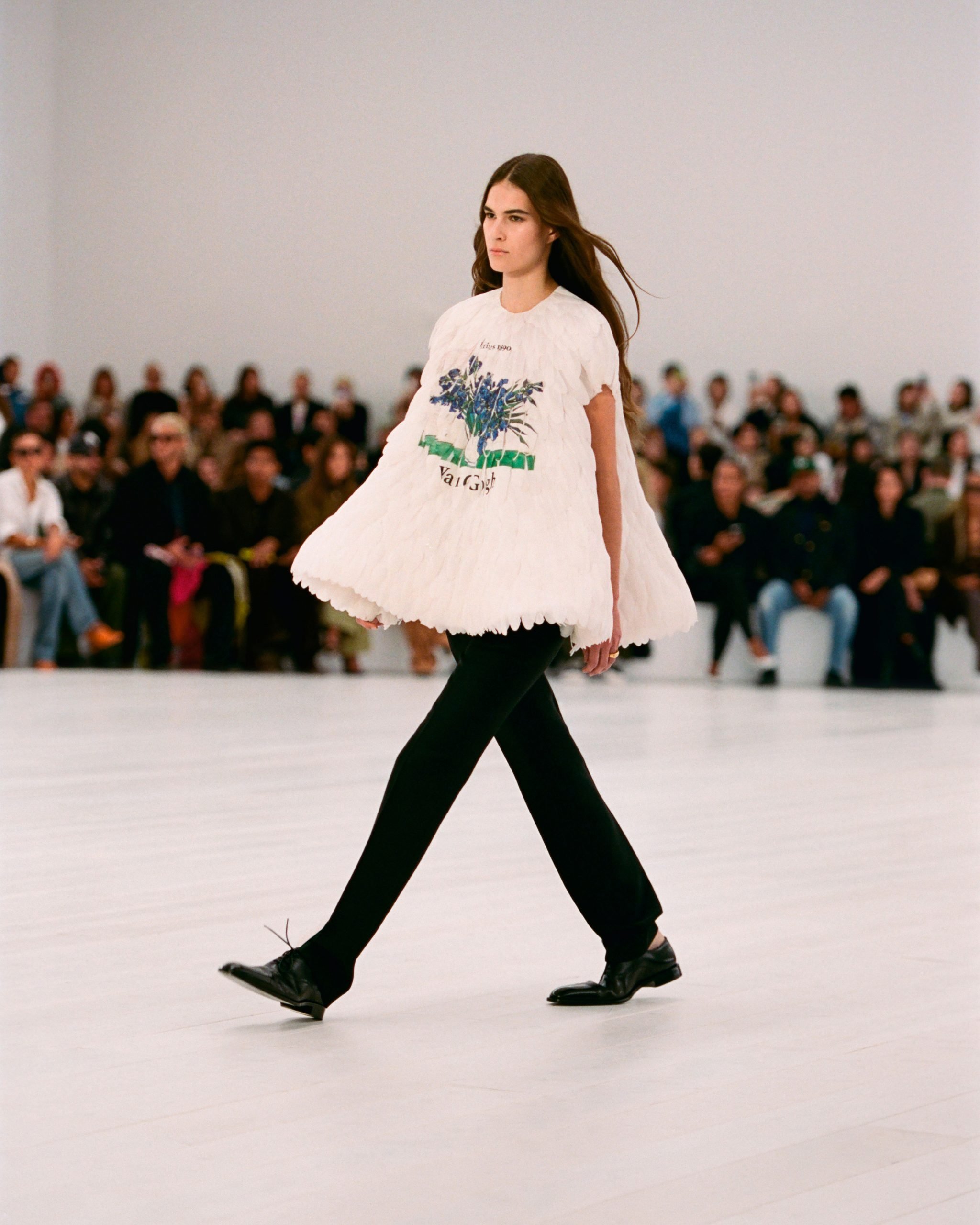
The worlds of fashion and fine art have crossed over once again. Loewe’s Spring 2025 collection showcased the fashion house’s own iteration of the timeless graphic tee, with tops featuring art by Vincent Van Gogh and Édouard Manet printed entirely on feathers.
Debuting during Paris Fashion Week, the collection featured structural silhouettes and unpredictable pairings: models in reimagined diaphanous French golden-age couture dresses, floral and hooped, wore hightop boxing sneakers on their feet. Interspersed among the swooping, boned designs were more subtle looks as some models walked the runway in t-shirts and slim pants, the printed feathers on their tees fluttering in tandem with each step.
Loewe Spring 2025 runway featuring Édouard Manet’s The Fifer (1866) on a feathered t-shirt. Photo courtesy of Loewe
One of the graphics on the shirts was of pioneering French modernist painter Manet’s iconic work The Fifer (1866). The portrait, a prime example of Realism, is of a young boy dressed in a vibrant red and black uniform, playing a fife, a small flute used in military bands. Manet’s unconventional use of minimal background details and solid, contrasting colors was considered groundbreaking. Critics were divided on his flat, abstracted style, but it became a significant influence on modern art.
Loewe Spring 2025 runway featuring Vincent Van Gogh’s iconic Sunflowers on a feathered t-shirt. Photo courtesy of Loewe
Another of the plumed shirts, this one entirely yellow, depicted one of Dutch master Van Gogh’s equally iconic still life paintings from his “Sunflowers” series (1888–89). For Van Gogh, the flowers were a symbol of life—the embodiment of light and of the innocence of a simple existence. His mastery of the color yellow, along with complementary tones, was revolutionary, while his “Sunflowers” series is today regarded as a pioneering achievement in expressive, post-Impressionist art.
Loewe Spring 2025 runway featuring Van Gogh’s Irises (1890) on a feathered t-shirt. Photo courtesy of Loewe
The shirts are evocative of museum store memorabilia—but with a high-fashion twist. In another article of clothing, a top in an oversized, voluminous silhouette flares out dramatically from the shoulders to form a bell-shaped short-sleeve blouse. The printed design on its front is of Van Gogh’s Irises, painted in 1890 during the artist’s stay at a mental asylum in Saint-Rémy-de-Provence, France. The original painting is currently on display at the Met in New York.
Loewe Spring 2025 runway featuring Barbara Krafft’s portrait of Wolfgang Amadeus Mozart on a feathered t-shirt. Photo courtesy of Loewe.
Elsewhere, classical musicians take the stage. Austrian painter Barbara Krafft’s 1819 portrait of Wolfgang Amadeus Mozart and Ary Scheffer’s 19th-century depiction of Frédéric Chopin both make appearances on feathered tees. The former work, created after the death of the musical prodigy, remains Krafft’s most enduring and recognizable paintings, while the latter is one of Scheffer’s many studies of the Polish composer.
“The only place you came to me was in my sleep” (2017) is a sculpture of a little bronze-cast bird perched atop a post by British artist Tracey Emin. Image courtesy of Loewe
While feathers and flowing floral fabrics gave Loewe’s show a flick of levity and a touch of nature, the show itself was punctuated by a delicate sculpture by Tracey Emin, installed in the center of the venue. The only place you came to me was in my sleep (2017) is a sculpture of a little bronze-cast bird perched atop a post, anchored the otherwise entirely plain white space, a focal point surrounded by cat-walking models and onlooking attendees. A statement from Loewe described Emin’s work: ”Caught in a moment of pause, [Emin] encourages us to imagine the bird’s imminent flight, and ultimately its freedom.”